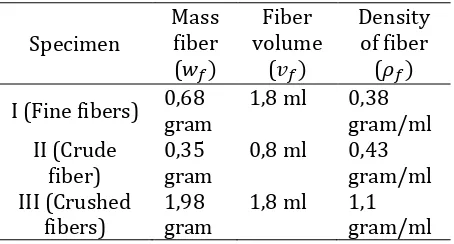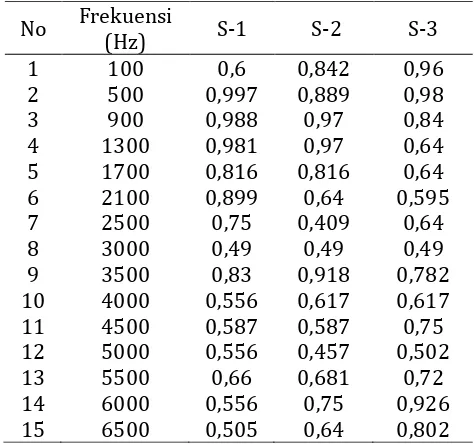Available online at http://journal.walisongo.ac.id/index.php/jnsmr
Characteristics of Coconut Coir Composite Acoustic with Epoxy Matrix
Lia Sholikhatul Amalia1, Andi Fadlan,1 Abdul Wahib1
1Department of Physics, Faculty of Science and Technology, Wallisongo State Islamic University
Department of Biology Education, Faculty of Science and Technology, Universitas Islam Negeri Walisongo, Central Java, Indonesia
Corresponding author: [email protected] Recived: 10 November
2015, Revised: 30
November 2015 Accepted: 27 December 2015.
Abstracts
The aim of this research is to measure the absorption coefficient of composite material synthesized from coconut fiber as filler and epoxy matrix and to discover the alternative interval of sound reducer material from natural resources, i.e (coconut fiber : fine fiber, rough fiber and crude fiber). After pressing, the sample was then cutted and examined using Bruel and Kjaer characterization. From the characterization process, the absorption coefficient of composite with filler of fine, rough and crude coconut fiber is calculated and found to be 0.997, 0.97 and 0.96, respectively. © 2015 JNSMR UIN Walisongo. All rights reserved.
Key words: Composite; Coconut fiber; Absorption Coefficient.
1.
Introduction
Noise is a sound that no human being likes [1], Not all loud or noisy sounds are perceived as a nuisance [2]. In general, noisy sound is one of the environmental issues that should be considered because it has a negative impact. Negative impact caused by noise is damage to hearing [3]. Negative effects of hearing loss are reduced hearing quality as well as noise (noise) so that it is not comfortable in hearing.
Noise not only causes only health problems, but also causes psychological / sociological disorders such as decreased work
productivity [4]. To overcome the problem of noise, usually used sound absorbing material that can control the noise. This material is commonly called acoustic material. Sound absorption is a change in sound energy into another form (usually heat), as it passes through a material or when striking a surface. The amount of heat energy generated at this energy change is very small, while the speed of sound wave propagation is not affected by absorption.
materials that are combined into a single unit. Material composed of mixtures of two or more different macro composers in form and / or composition and insoluble one another are called composites.
In general, the main composite material of the composite is a matrix and amplifier or filler (reinforcement)[6]. Matrix is a composite part which continuously encloses the amplifier and functions to bind the amplifier to one another and pass the load received by the reinforcing composite. Filler is a component that is incorporated into a matrix that acts as the main load receiver or holder suffered by the composite [7].
Coconut tree is a multipurpose tree because every part of this plant can be taken to meet some of the needs of human life [8]. Research on the manufacture of composite materials for acoustics from natural materials has been widely studied. Matrix and filler based acoustic fabrication of coconut fibers [9,10] and rice straw [11]. In this study, used filler in the form of coconut fiber and epoxy matrix. The focus of this article is to analyze the acoustic characteristics of coco fiber composites with epoxy matrix. sound absorbing material. Before the matrix is mixed with the filler, it is necessary to ensure that the matrix component (epoxy and hardener) is stirred first so that it is evenly mixed. The data of fiber and matrix composition used can be seen in Table 1.
The comparison between epoxy and
Tabel 1. The Composition of Composite Acoustic
Specimen Composition (gr) Pressure (kg/cm2) calculation. Determination of volume fraction of fiber and matrix can be obtained from the following Equation 1:
(1)
where:
: Volume fraction of fibers (%) : Mass of fibers (gr)
Tabel 2. The fractions on each fiber and matrix
The stirred matrix and filler are incorporated into a plastic coated mold and smeared with vaseline. The filler and matrix composites are inserted into the mold with little pressure applied to fit and mold. The next step is pressing process with pressure 10 kg/cm2 for 20 hours. The mold used for the manufacture of this specimen with a thickness of 10 mm. The process of making specimens is done with the model of Hand Lay Up.
Tests of specimens produces the quantities used to determine the absorption coefficient value of the composite material. These are the maximum pressure (Pmax) and minimum pressure (Pmin). Data obtained from this test, then analyzed by using the equation to calculate the value of absorption coefficient α obtained.
The absorption coefficient α of a material is defined as the ratio between the absorbed energy and the total energy which is about the material. Absorption coefficient can be known by Equation 2:
where
(2)
3.
Result and Discussion
The results of absorption coefficient data α from each specimen can be seen in Table 1. Specimen 1 (S-1) is a specimen with a filler that has a fine fiber. From the data in Table 3, it can be seen that the best absorption coefficient α in specimen is .997. These specimens are more effective at low frequencies, ranging from 500 to 1300 Hz. Testing of specimen 1 at high frequency obtained by value of absorption coefficient α decreasing. This indicates that the noise absorbing material for specimen 1 is not optimally used as noise absorbers. This is
Figure 1. Graph of frequency relationship and absorption coefficient of Specimen 1
Figure 2. Graph of frequency relationship and absorption coefficient of Specimen 2
Figure 3. Graph of frequency relationship and absorption coefficient of Specimen-3
The specimen-3 (S-3) is filler material used from coconut coated meat first until smooth. From Table 2, it is seen that the best absorption coefficient value in the frequency range is 1300-2500 Hz. This indicates that the composite in sample 3 can be used as noise absorbers, This specimen 3 has a composite composition visible dense and solid. The best absorption coefficient α value in this specimen is at a frequency of 500 Hz, which is 0.96. The graph data value of the absorption coefficient of specimen-3 is shown in Figure 3. Composite silicone composite research has been studied by previous researcher [9], the value of absorption coefficient produced is 0,51. This has fulfilled the requirements for a silencer under ISO 11654.
Based on the value of absorption coefficient as shown in Table 1, it can be seen that each specimen is effectively used as a low noise at low frequency. Composite noise absorbers of the three specimens that are best for low frequency noise absorbers are specimens 1 and 2. This is because the value of the absorption coefficient α for the best absorbers. Based on the data of the absorption test that has been done, the three specimens are more effectively used as noise absorbers at low frequency. Composite noise absorbers at high frequencies more effectively use specimen 3.
Acknowledgment
References
[1] Harold W.Lord, Noise Control for Engineers. New York: McGraw-Hill, 1980.
[2] Y.B. Mangunwijaya, Pengantar Fisika Bangunan. Jakarta: Djambatan, 1997. [3] Sidik Hananto, Handout Perkuliahan
Mata Kuliah Fisika Bangunan. Bandung, 2010.
[4] Mackenzie L. Davis, Introduction to Enviromental Engineering. New York: McGraw-Hill, 2008.
[5] Lawrence H Van Vlack and S. Djaprie, Foundation of Material Science and Engineering. Terjemahan. Jakarta: Erlangga, 1985.
[6] William F.Smith, Foundation of Material Science and Engineering. New York: McGraw-Hill, 2006.
[7] P.K Mallick Newman, Composite
Materials technology. New York: Oxford University Press, 1990.
[8] NN, Tanaman Kelapa, Yogyakarta:
Kanisius, 1988, p. 5
[9] Aini, K., Desain Peredam Suara Berbahan Dasar Sabut Kelapa dan Pengukuran Koefisien Penyerapan Bunyinya, Berkala Fisika, Vol.9, 2006 [10] Yusril I.
Karakteristik Akustik Papan
Komposit
Serat
Sabut
Kelapa
Bermatrik Kerami
k, Bandung:Institut
Teknologi Nasional, 2009.
[11]


